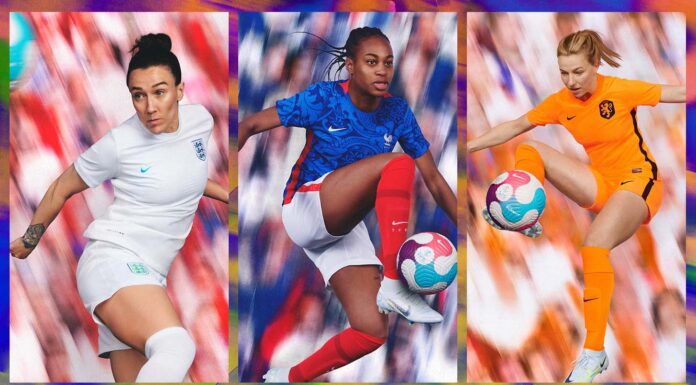While the current generation of stars still have plenty left in the tank, a new crop of USWNT players have been developing — and they’re now ready to break through.
Death, taxes, and Julie Ertz at holding mid. These resolute constants have remained true for some time, but over the past year, one of them has somewhat wavered (to the chagrin of Succession’s Connor Roy, it’s not taxes).
Ertz suffered a gruesome MCL injury last May, and while it wasn’t enough to keep her out of the 2020 Olympics, her trademark long shorts and pre-wrap headband have been missing at the No. 6 position for much of 2021, including the four friendlies since the Summer Games concluded. Andi Sullivan has stepped into the role quite nicely, and while Ertz’s showing in Tokyo on more or less one knee still suggests she is an institution at the position, Sullivan’s performance is indicative of a larger phenomenon throughout the United States women’s national team: The next generation is here.
For the past five years, the USWNT lineup has been as predictable as it has been dominant. Since 2017, it’s been a mix-and-match of a handful of players in the 10 outfield positions, with Alyssa Naher at keeper. Mainstays have included Tobin Heath, Alex Morgan, Christen Press, Megan Rapinoe, and Carli Lloyd up top; Ertz, Lindsey Horan, Sam Mewis, and Rose Lavelle in the midfield; and Crystal Dunn, Becky Sauerbrunn, Abby Dahlkemper, and Kelley O’Hara on the back line. Sure there have been others — Emily Sonnet, Lynn Williams, and Casey Krueger to name a few — but the majority of USWNT playing time over the past half decade has gone to 14 players.
The consistency in the USWNT lineup is a testament to the players’ longevity, but as we all know Father Time is undefeated. While the current generation of stars were showing out at the highest level, a new crop of talents were not-so-quietly developing — and now they’re breaking through. Last week’s 6-0 victory over South Korea represented Lloyd’s 316th and final cap for the U.S., and it may have also been the dawning of a new era.
Along with the 25-year-old Sullivan, a host of sub-25-year-olds have recently received regular call-ups including Sophia Smith (21), Emily Fox (23), and Catarina Macario (22). The foursome all have 20 or fewer caps yet have shown plenty of promise both in their brief time with the national team and on their domestic clubs.
Fox’s strong play in the 6-0 victory was particularly promising, and if she can continue to show out at left back, it frees up Dunn, who has played much of her national team career there, to move to her natural forward position. This would mark the end of the absurd compromise Dunn has had to make for the sake of the team. She’s been arguably the USWNT’s best player over the past five years, and she hasn’t even played her primary position.
Also in the mix are a host of more experienced yet still very young players, including Mallory Pugh (23, 67 caps), and Tierna Davidson (23, 43 caps). Pugh, who made her senior team debut at just 17, has seen her role diminish in recent years due to injuries, but she’s returned to form in 2021, reminding us why we had her pegged as the future of the USWNT when she was added to the 2016 Olympic roster.
Davidson, who was the youngest member of the 2019 World Cup-winning squad, looks to be the heir apparent to Sauerbrunn at center back. Physical, calm, and creative, the Stanford product has shown all the signs of being the back line anchor of the future.
In the midfield, Macario and Sullivan respectively add dazzling flair and sure-footed stability to what’s already a strong core. Sullivan has demonstrated that she can fill in nearly seamlessly for Ertz, and Macario’s dynamic playmaking ability echoes that of Lavelle. Paired with Mewis and Horan and you have a ridiculously talented and balanced group that can create, defend, and score at will.
In addition, a few upcoming prospects could give Sullivan a run for her money at the No. 6 spot. Jaelin Howell, currently a senior at Florida State, has long been a top USWNT prospect. In 2020, she won the Mac Hermann trophy for the top women’s college soccer player while also making her senior USWNT debut. There have also been rumors that the U.S. has been targeting Olympique Lyon’s Damaris Egurrola, who has previously played for the Spanish national team but is eligible to switch to the U.S. Perhaps her Lyon teammate Macario can coax her into joining the dark side, although it may be a difficult sell with all the competition for her position.
We’ve also yet to see Trinity Rodman, the 19-year-old phenom that has taken the NWSL by storm in her rookie year, make her senior team debut — but that’s a matter of when rather than if. Rodman, along with Smith, Dunn, Pugh, Williams, Press, and Heath, make for an eye-poppingly deep attacking front with countless different options.
The current guard still have plenty of tread in their tires, as Lavelle, Dunn, Williams, Mewis, Ertz, and Horan have all yet to celebrate their 30th birthdays, and neither Press, Heath, nor Morgan have shown any signs of slowing down. So we won’t exactly see a radical shift in who is playing just yet, but the new crop of youngsters will certainly both push the established players to be better and give them some much needed rest.
For now, it is a question of when USWNT head coach Vlatko Andonovski will give the new players a chance. In the disappointing bronze medal campaign at the 2020 Olympics, many were critical of Andonovski sparingly playing Williams and Macario, and not even including Sullivan on the roster. And with no scheduled games in the near future, it is still uncertain when we will see a revamped squad in action.
But one thing is clear — the USWNT has yet another golden generation on its hands. As the rest of the world has closed the gap on the U.S.’s dominance, the Americans have upped their games as well.








